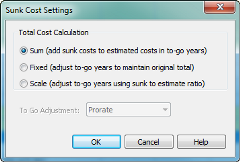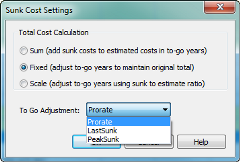by
User Not Found | Oct 30, 2018
Sunk costs are a common factor in the cost estimating process as a program evolves through the milestone acquisition process and estimated costs become actual, incurred costs. Some questions about the application of sunk costs in ACE came up during the ACEIT Working Group this past September, so we thought now would be a good time to review these settings. Whether you are already using the basics of ACE’s sunk cost feature and want to take your knowledge to the next level, or you are just finding out about this feature for the first time, the following information will help you get started.
The sunk cost settings in ACE 7.5 provide a way for you to specify how sunk costs should be handled, what the new total should reflect, and how the to–go estimate should be calculated. The Sunk Cost Interpretation column on the Yearly Phasing Workscreen allows you to specify how both the total and “to-go” years should be calculated. Right click the column and select “Edit Sunk Cost Spec…” to find the following dialog:
 |
 |
There are three Total Cost Calculation options provided by ACE:
Sum – Default option.
Fixed – Leaves row total unchanged.
Scale – Adjusts row total based on ratio between total sunk costs and the total underlying estimate.
We also offer a drop down menu with to-go adjustments including:
Prorate – Default option. It scales the yearly to-go values to match the desired total.
Last Sunk – This options uses the last year a sunk cost is entered and extends this value to all the to-go years, replacing the estimate methodology.
Peak Sunk – This option uses the largest sunk cost value to extend to-go years.
You can find more information on all of these settings, as well as how to enter sunk costs in your session, by searching “sunk cost” in the ACE 7.5 Help Text. Don’t worry, you will have access to these Sunk cost settings in ACE 8.0 as well.
If you have any questions about sunk cost, please contact
[email protected].